|
|
|
|
This is Part Two of a 2 part posting. Last week was Part
One - Sword 1. It featured what is believed to be a militia staff
officer's sword (variant) of the Mexican War period (1845-1850). This
week we are featuring the second of these unusual large straight swords.
I could not find it or a similar U.S. blade in any of my sword books
nor do I remember seeing another like it at any shows featuring antique
U.S. military swords. As stated in Part 1, not all U.S. swords can
be found in books. There are always those specimens that languish
in closets, museum storage spaces, on dealer's tables or in private
collections that have no names and/or no absolute known time of manufacture
or usage. Some are beautiful, others are not so beautiful. Last week's
sword was somewhat attractive, but this week's item is pretty much
of a plain Jane. However, it does have one thing that last week's
sword did not. It has a name. The name "W. H. Horstmann & Co"
on the obverse and "New York" on the reverse ricasso. To try and identify
it I went through several books and based on swords with the exact
name in
the exact script format, I'm assuming it to be a very early Horstmann
mounted infantry militia officer's sword from the period of 1841 -1845.
If anyone has any other information on this sword, I would welcome
your comments.
|
|
|
|
|
|
|
|

MOUNTED INFANTRY MILITIA OFFICER'S SWORD (VARIANT) 1841-1845
|
|

"W. H. HORSTMANN & CO."
|
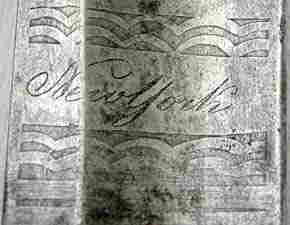
"NEW YORK"
|
|
|
|
|
This reverse P guard sword is 38-3/4" overall with a blade length
of 34". The straight blade is single edged to within 5-5/8"+/-
of the point where it becomes a doubled edged blade that tapers somewhat
radically to a center point. At the hilt it is 1-7/32" wide
with a thickness of 5/16". The broad fuller extends 27-1/2" to within
6-1/2" of the point. The blade etching extends to approximately 13"
above the name panel. The etching pattern, consisting of floral scrolling
with a more or less centered military trophy motif, is the same on
both sides of the blade. There is no bluing. The etchings are in the
white. The forte (top of the blade) is etched with a leaf design.
No makers mark can be found on the blade.
|
|
SWORD POINT BACK TO FULLER
|
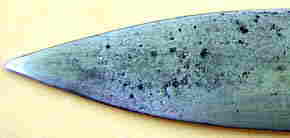
CLOSE UP OF SWORD POINT
|

TOP OF BLADE (FORTE) ENGRAVING
|
|

LOWER ENGRAVING - OBVERSE
|
|
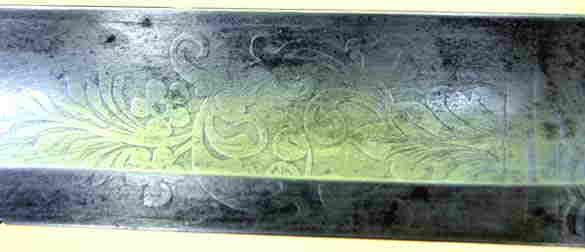
LOWER ENGRAVING - REVERSE
|
|

MILITARY TROPHY ENGRAVING - OBVERSE
|
|

MILITARY TROPHY ENGRAVING - REVERSE
|
|

UPPER ENGRAVING - REVERSE
|
|
|
|
|
|
The 4-11/16" iron hilt has langents 3/4" long and 15/16" wide at the
top. The reverse P form iron knuckle bow is pierced for a sword knot.
It extends out about 3" from the grip at it's widest point. The grips
are wood, covered by black leather and are wound with 2 strands of
twisted copper wire. The iron back strap extends to the bird's
head pommel. The 1-5/8" long quillon terminates above the blade
in a disc finial. There are no surface decorations anywhere on the
hilt. The black undecorated metal scabbard has two ring mounts. The
upper ring mount is 2-7/8" on center from the scabbard throat. The
lower ring mount is 7-5/8" on center from the upper mount. The rings
have an outside diameter of 1-1/8". A small drag is at the tip.
|
|
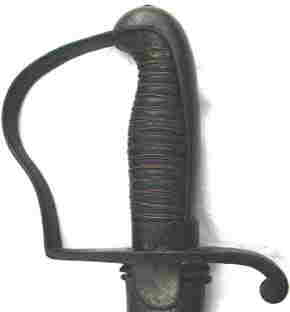
OBVERSE VIEW OF HILT
|
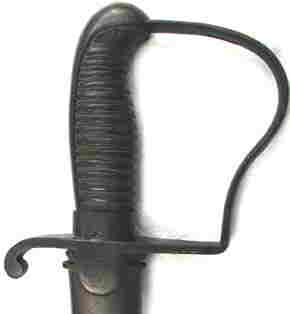
REVERSE VIEW OF HILT
|

TOP OF POMMEL VIEW
|
|

SCABBARD RING MOUNTS
|
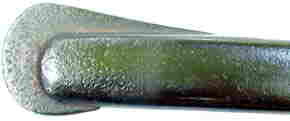
SCABBARD DRAG
|
|
|
|
|
Here is a picture of last week's "Sword
Of A Different Ilk":
|
|

MILITIA STAFF OFFICER'S SWORD (VARIANT) 1840-1850
|
|
|
|
|
|
Again, no reference books were brought into play for this weeks posting
as none of my books referenced this sword. It was obviously a sword
with limited production.
|
|
|
My son and webmaster, Reed Radcliffe, gets the credit for posting
this entry and for the design and maintenance of this web page.
|
|
|
Dave Radcliffe
|
|